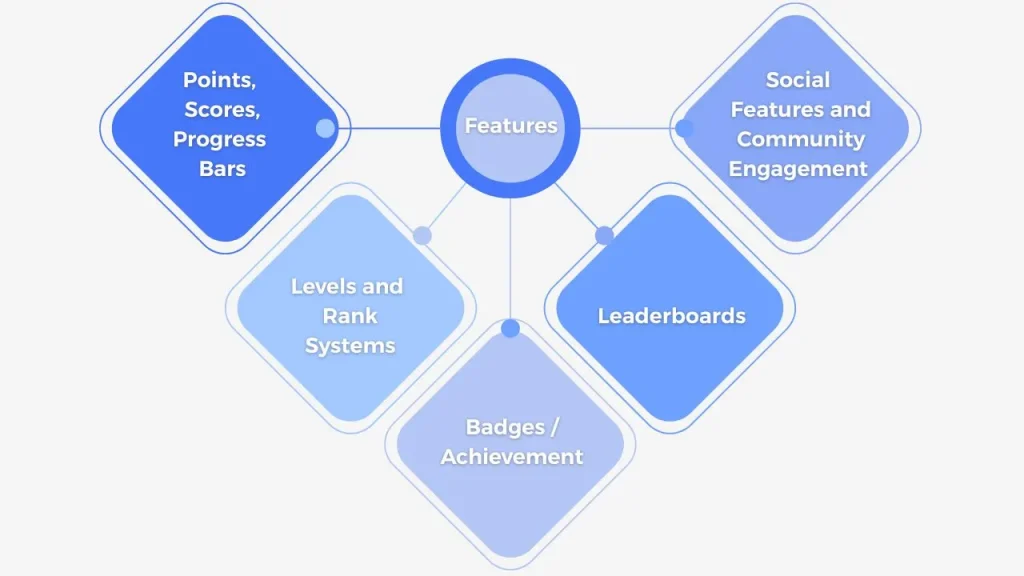How Gamification is Transforming Player Engagement and Retention for Scaling B2B Gaming Platforms

Table of Contents
- Introduction
- What makes Gamification so Effective?
- Key Gamification Features that Hook Players
- How B2B Platforms Use Gamification to Scale Faster
- Metrics That Matter: Tracking Engagement and Retention
- Challenges and Compliance Considerations
- Future Trends: AI, Personalization, and Beyond
- Tecpinion: An Ideal Choice for your B2B Gaming Platforms
- Conclusion
- FAQs
Introduction
The gamification aspect has been proven to be really effective in a B2B gaming platform in boosting user engagement and satisfaction. Let’s discover how companies can maximize the benefits of gamification elements.
The demand for online social gaming platforms is increasing, with a growing player base worldwide. Does it mean that all gaming software solutions can experience smooth growth? There is definitely a demand for online games, but higher expectations also need to be met to achieve success.
The gaming software solution market is expanding at a vibrant pace, with the rise of new entities offering their products and services in the industry. Therefore, it has become crucial for businesses to channel their resources and focus on improving key operational aspects to achieve better results and establish a strong market presence.
Gamification tools have been a key operational aspect, as they have been a driving factor that boosts productivity and performance. The advancements and developments in gamification have made it a critical component responsible for player engagement, retention, and the overall platform’s scalability.
Market Stats:
The market size of gamification was valued at USD 22.2 billion in 2024 and is expected to reach USD 102.5 billion by 2033, with an estimated annual growth rate of 18.53%.
What Makes Gamification So Effective?
It contributes to both intrinsic and extrinsic motivation of the players. Intrinsic refers to the level of users’ satisfaction with completing new challenges and honing their skills further. Intrinsic motivation varies from user to user, but factors such as features, functionalities, game-like experiences, and rewards play a major role in it.
Extrinsic motivation encompasses tangible rewards, such as bonuses, rankings, or loyalty points, that provide external incentives for achieving goals. The winning strategy for a B2B gaming platform would be to create an ecosystem that blends game mechanics with human psychology, making players feel both emotionally rewarded and materially valued.

-
Psychology Behind Engagement:
1. Attributes like progress bars, levels, and milestones give them a sense of accomplishment.
2. Leaderboards and tournaments facilitate healthy competition among players.
3. Providing real-time feedback increases confidence and motivates them to play better. -
Data-Driven Approach:
1. Advanced gamification systems constitute a personalized experience using AI tools.
2. This data helps operators customize challenges, tailor rewards, and targeted incentives that resonate with users.
3. This approach will help build both engagement and loyalty. -
Build Community:
1. Building online communities in the gaming space gives players a sense of belonging.
2. Features like group missions, team challenges, or social leaderboards can have a networking effect.
3. It also increases the organic growth of the platform. -
Business Perspective:
1. This system has led to prolonged duration and increased frequency of play.
2. A drastic rise in conversion rate is contributing to a larger player base.
3. Improved customer lifetime value, making the business more sustainable.
The following elements make gamification more impactful, especially in online gaming platforms. Moving forward, let’s look into the key gamification features that attract new players to the platform.
Key Gamification Features that Hook Players
The following are key gamification elements that have been proven effective in enhancing engagement and retention.

1. Points, Scores, Progress Bars:
- It has been the groundwork for gamification that works by providing instant feedback to satisfy players.
- This also reflects an increase in coins, experience points, and loyalty credits.
- In B2B gaming platforms, these systems are synchronized with player milestones and tournament results to convert engagement to progression.
2. Levels and Rank Systems:
- Setting clear goals and rewards for achievement can add layers to the player journey.
- It can also be perceived as a VIP or loyalty program, offering users a sense of prestige for getting higher ranks.
- Multi-tier models reward players in the form of cashback percentages, free spins, or personalized bonuses.
3. Badges / Achievement:
- Badges and trophies motivate players by helping them gain status and recognition within the community.
- Users get awarded after completing short-term goals, such as first win, 7-day streak, which reinforce consistent participation.
- A valuable social tool to showcase their skill to fellow players.
4. Leaderboards:
- Leaderboards enable players to compare their performances in daily challenges, tournaments, and other events.
- Users can be driven to outperform their peers to reach the top.
- Create an engagement cycle, where players return regularly to reclaim their positions.
5. Social Features and Community Engagement:
- Team-based challenges, friendly referrals, shared achievements, and thriving social interactions.
- Dedicated forum where users can connect, collaborate, and compete within the same ecosystem.
- This can even influence casual games to become loyal brand advocates.
How B2B Platforms Use Gamification to Scale Faster
In the dynamic B2B gaming landscape, growth isn’t just about bringing in new operators or end-users– it is rather a framework that enables sustained engagement, improved retention, and contributes to higher revenue generation.
-
Transform Engagement to Growth Engine:
1. Creates continuous engagement loops to encourage players to visit regularly, compete in missions, and unlock rewards.
2. This can lead to higher player lifetime value and also reduce churn rates, making the retention process more effective.
3. Constant traffic within the platform with the rise in daily active users and monthly active users. -
Operators Retention and Satisfaction:
1. Offering powerful gamified features can also strengthen relationships with B2B clients.
2. Possibility of top-tier benefits for operator partners, such as marketing credit or fee discounts, after attaining engagement milestones.
3. B2B software providers often gamify performance tracking, which indirectly encourages operators to scale their own user base. -
Personalisation:
1. That system is enabled with advanced data analytics and AI that personalize the user experience.
2. It automatically customizes challenges, rewards, and tailors game journeys.
3. This feature keeps players continuously engaged, amplifying platform activity. -
Rise in Revenue Generation:
1. Retention has been the key pillar for stable revenue generation.
2. Loyalty programs, tournaments, and achievement bonuses can foster activity and spending.
3. Platforms can scale faster without relying only on new users. -
Uniqueness in Brand Identity:
1. Gamification offerings can help operators create a unique identity in the market.
2. B2B software developers are using the gamification aspect to position themselves as innovation-driven, player-centric partners.
3. Highly beneficial for development services in attracting new clients and retaining existing ones.
How can a B2B gaming company determine the impact and effectiveness of gamification tools? For this, companies use key metrics that help them track and grow.
Looking for Gaming Software Providers?
Metrics That Matter: Tracking Engagement and Retention
1. Player Engagement Rate
- The average session duration indicates how long players engaged with the platform.
- Session frequency rate measures how often they return.
- The interaction rate shows the number of actions performed during a single session.
2. Retention Rate
- First day, first week, and first month are common timelines used to measure retention rates.
- Churn rate refers to the percentage of users who leave, which is inversely proportional to retention rates.
- Cohort analysis is a term used to describe how targeted plate groups behave after a campaign.
3. Player Lifetime Value (LTV)
- It calculates the total revenue that the player contributes during their engagement cycle.
- LTV helps in the player segmentation process.
- Operators can optimize engagement strategies to achieve a higher monetary return.
4. Active User Metrics
- Regularly keeps count of daily, weekly, and monthly active users.
- It reveals the platform’s overall health and growth.
- Gamified campaigns, such as daily missions and leaderboards, encourage consistent participation.
5. Conversion and Reward Redemption Rates
- Responsiveness level for gamified incentives, such as completing missions and claiming bonuses.
- High conversion or redemption rates suggest that the reward framework is well-aligned and meaningful, motivating players.
- These rates help a B2B gaming company utilize gamification mechanisms to increase engagement.
Challenges and Compliance Considerations
Gamification in the B2B platform is an influential tool that taps into the behavioral psychology of users, encouraging them to repeat actions that lead to positive outcomes. However, it presents a unique set of operational, ethical, and regulatory challenges.
-
Balancing Engagement with Responsible Gaming:
These designed elements can drive players towards excessive or compulsive play if not properly managed. Certain gamification mechanics can create undue psychological pressure that can lead to addiction rather than healthy engagement.
-
Regulatory Compliance:
The gambling laws vary widely across jurisdictions. For B2B platforms operating on a global scale, integrating gamification that aligns with multiple legal frameworks becomes a complex task. Highly possible to face compliance issues about advertising, promotion, and data privacy.
-
Data Security:
Personalized gamification revolves around data collection and behavioral tracking. It introduces privacy and ethical concerns, especially if it's unable to comply with data governance norms.
-
Operational Integration Complexity:
Integration of gamification features requires a modular gamification framework to prevent technical inefficiencies, an inconsistent user experience, and reward exploitation. Developing a modular gamification framework demands technical expertise and resources, proving to be a challenge for small-scale operators.
-
Fairness and Transparency:
Gamified mechanics should operate on the principles of fair play. The B2B platforms with biased leaderboards, opaque reward algorithms, or unfair player treatment give rise to trust and credibility issues.
Therefore, B2B platforms should carefully consider the above challenges when integrating gamification tools to ensure that business operational activities are both legally compliant and user-friendly. Moving ahead, let us uncover the future trends in gamification.
Future Trends: AI, Personalization, and Beyond
1. Adaptive Gamification
- It enables personalized player journeys, making it more interactive.
- Anticipates players’ dip in points and automatically triggers a reengagement campaign.
- Predictive analysis is useful in predicting revenue impact and optimizing retention strategies.
2. Use of Data and Behavior Insights
- It helps categorize players by psychographics and tailor leaderboards and ranking systems accordingly.
- Some users might be encouraged by story-driven missions and mystery rewards.
- Social players may thrive on collaborative challenges and community-based goals.
3. Blockchain and Digital Ownership
- It helps maintain provable fairness in reward distribution and leadership rankings.
- Tokenized rewards and NFT systems enable players to truly own and trade their achievements.
- Immutable tracking of loyalty points and progress across various operators.
4. Immersive Technologies
- These technologies provide players with a multi-sensory experience.
- Mataverse gaming hubs are a shared space where users from multiple operators can compete.
- These tools can keep the players hooked with the platform for longer periods.
5. Ethical and Responsible Gamification
- AI-driven responsible gaming systems can detect risky behavior early and make necessary modifications.
- A reward algorithm that ensures transparency about terms and conditions.
- Gamified tools that promote healthy play and balance.
Tecpinion: An Ideal Choice for Your B2B Gaming Platforms
Tecpinion has been the top provider of robust B2B gaming platforms driven by customization, performance, and compliance. Their skilled and experienced professionals design software that adheres to the global standards in terms of innovation and quality. The software is integrated with advanced tools and technologies that help platforms scale faster.
Their AI-powered gaming solutions feature a LifetTime Value (LTV) model, a Deposit Forecasting Model, Game Recommendation and Fraud Detection Models, which are critical for sustainable growth and development.
Conclusion
Gamification elements have been very pivotal to the growth of iGaming platforms. It has tremendously helped operators gain visibility and also enhance the level of player loyalty and retention. These gamified systems are structured to maintain the platform’s overall health and generate higher ROI.
The tools, such as Augmented Reality (AR), Virtual Reality (VR), and Metaverse, provide users with multisensory experiences that trigger excitement and boost user satisfaction. With the presence of gamified elements, gambling operators can easily adopt a user-centric approach to increase engagement.
While it presents opportunities for growth and development, it also presents significant challenges. This could include issues with regulatory compliance, data privacy, advertising, and promotions that can lead to legal consequences. Therefore, operators must be more vigilant regarding these gamified aspects.
FAQs
- How does gamification help with engagement?
The presence of gamification elements will provide customers with immersive experiences, keeping them engaged and entertained for a longer duration.
- Does gamification improve retention?
Gamified mechanics create a continuous engagement loop, encouraging users to visit frequently to complete challenges or tasks.
- What is the main purpose of gamification?
The core purpose of gamification is to enrich the user experience by incorporating game elements, such as points, leaderboards, and badges.
- What are the benefits of gamification?
The benefits of gamification include hyper-personalization, improved retention and satisfaction, increased revenue, and enhanced brand identity.
- How to measure gamification success?
Metrics used to measure success in gamification include player engagement rate, retention rate, player lifetime value (LTV), active users, and conversion and redemption rates.


